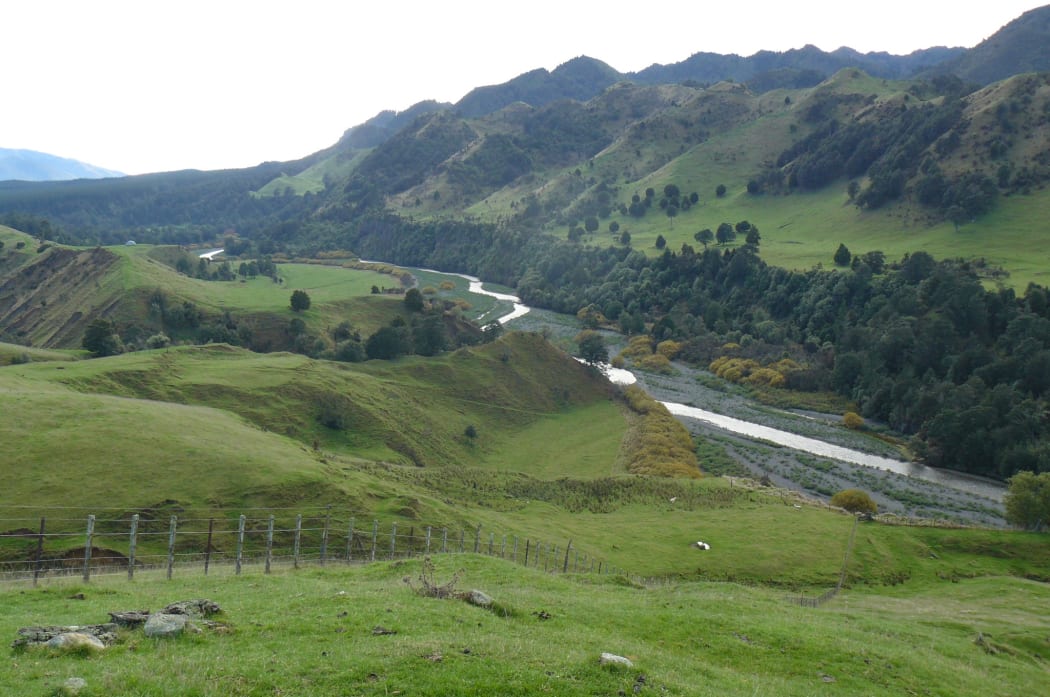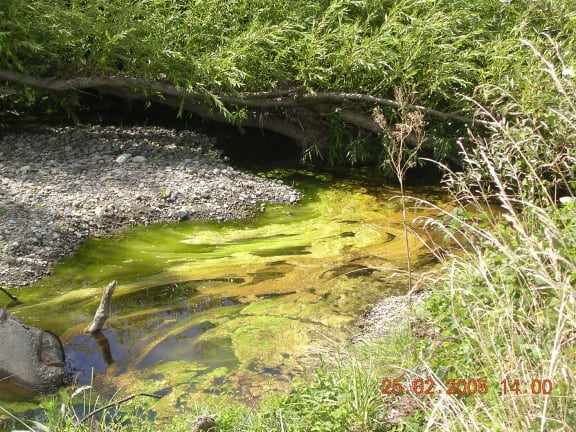A draft Department of Conservation submission on the Ruataniwha Dam water storage project says the Hawke's Bay Regional Council proposal is a risky and untested approach to water management which could kill the rivers involved.
The draft submission obtained by Radio New Zealand News was written for the Board of Inquiry into the dam, but was not submitted.
Instead, DoC submitted a brief "neutral" document which does not raise concerns about what could happen to water quality and the dangers for at-risk fish species in the Tukituki and Waipawa Rivers and tributaries.
But the Conservation Minister, Nick Smith, says he gave no indication to the Department of Conservation about what they should include in their submission on the proposed Ruataniwha dam in Hawkes Bay.
The outcome of the Ruataniwha dam proposal is of national significance. A Cabinet Business Committee paper released to Radio New Zealand News under the Official Information Act says the Hawke's Bay process is "guiding water management planning in other areas of New Zealand" and "the process may be used as a prototype for other areas" of the country.

The site of the proposed Ruataniwha Dam. Photo: RNZ
In Parliament on Tuesday, the Green Party co-leader Russel Norman asked the Minister if he gave any indication to the Department about the direction or content of the submission.
Dr Smith told the House he was informed of the debate going on inside DoC, but the final submission was a decision for the department.
The Environmental Protection Agency has publicly notified the Hawke's Bay Regional Council's Tukituki Catchment Proposal after it was called in by the Minister for the Environment and Minister of Conservation. Public submissions closed at the end of July and the submissions will be the subject of public hearings in November.
The regional council proposal has two key components: Plan Change 6, which is the improvement of water quality within the Tukituki catchment through the control of periphyton (including "toxic algae"), and the construction of a $600 million reservoir and water storage project.
With the intensification of agriculture as a result of the dam and others proposed around the country, much greater stock numbers mean much more effluent, leadint to a significant rise in the amount of nitrates leeching into aquifers and streams through their urine and fertiliser use.
Professor Russell Death from the Massey University Centre for Freshwater Ecosystem Management and Modelling says an extensive array of scientific research shows to control toxic algae in rivers, the amount of both nitrates and phosphates needs to be controlled.
Hawke's Bay Regional Council has commissioned a laboratory-only study which says in the specific case of the Tukituki River only phosphates have to be controlled. The council has called this "one nutrient management".
As a result it has proposed in Plan Change 6 an increase in nitrates of up to 500% on current levels in the Tukituki and Waipawa rivers and tributaries to "toxic levels."
The Hawke's Bay Regional Council says it can understand the level of anxiety around its proposed Ruataniwha water storage scheme because its approach to water management in New Zealand is new.
The Regional Council chief executive, Liz Lambert, says DoC has worked closely with her officials around the nutrient management approach, which seeks to limit phosphorus but not nitrogen.
Ms Lambert says the single nutrient management approach is relatively new in New Zealand and there is always a level of anxiety with something new.
A 'risky approach'
The draft DoC submission notes the regional council plans for one-nutrient management is a "new untested approach" in New Zealand. "Managing a single nutrient only is a risky approach", it says.
Specifically, the paper says the risks associated with the regional council's approach include:
- "The 'blanket approach' of the management of PC6 "may not be sufficient to provide for the life supporting capacity of freshwater" in tributaries … the result being that algae blooms could be more evident in the tributaries."
- Regional council nitrate research is laboratory based, utilizing only a small suite of species and "there is a risk of uncertain environmental outcomes when this is applied in the real world."
- Toxicity testing has not been undertaken on the most vulnerable native species.
- Plan change is "silent" on changes to nutrient discharge on ecologically significant Tukituki Estuary and wetlands and lakes.
- The ability to reverse the problem should adverse effects become evident. Ie how quickly they can achieve a reduction in the output of nutrients from farms.
"The outcome of any changes to the approach to water quality management and nutrient management may impact on the amount of land that can be intensified and therefore the economic viability of the dam," it said.

Toxic algae can choke rivers which have a high concentration of nutrients. Photo: MASSEY UNIVERSITY
DoC says the draft submission, in principal, does not oppose the management of toxic algae by managing one nutrient, provided sufficient tools are available to monitor and review this approach.
"The department's internal subject matter experts have concerns sufficient management tools exist to monitor and review this approach. If adverse effects become evident later, the ability through the regulatory process to respond in a timely manner is limited," it said.
Professor Death says this means there is little opportunity to reverse any damage that is done.
"It's not like we will be able to remove the dam after it has been put in place or get rid of a lot of the intensive agriculture once it's established," he says.
The draft submission says:
- PC6 does not give effect to the National Policy Statement for Freshwater Management 2011.
- The proposal does not give effect to the New Zealand Coastal Policy Statement 2010 and potential effects on the coastal environment.
- The proposal does not give effect to the Regional Policy Statement.
"The risks … have not been fully assessed, and as a result there is an inadequate management response in PC6 for potential effects which may have a high potential impact," it said.
'Internal report'
Dr Smith says the leaked draft submission was not submitted because it was an internal report that managers did not agree with.
Dr Smith says DoC took the view it wanted to focus on 22 hectares of department land that will be inundated by the dam rather than issues of freshwater quality.
He says the primary responsibility for freshwater quality lies with the Hawke's Bay Regional Council, which is also developer of the dam.
Dr Smith says he does not consider it a conflict of interest that the council is both the project's developer and its environmental regulator.
But Fish and Game resource management co-ordinator Neil Deans told Nine to Noon it is hard not to conclude that someone has told DoC not to submit its original draft.
"For them to have at the 11th hour not submitted on this we find perplexing and very disconcerting," he says.
Conservation values
The draft submission said DoC had chosen only to submit on resource consents relating to the construction, operation and maintenance of the dam. It said the cost was a significant consideration in determining what components of the Tukituki catchment proposal the department would submit on.
"The department does not believe the conservation values at risk in the Tukituki catchment justify the resource investment that would be required by the department to pursue changes to the regulatory process" in Plan Change 6.
The Tukituki catchment contains 18 native fish species and 8 are considered to be "At Risk". The draft submission said the Tukituki catchment was one of four catchments that were ranked as being nationally significant in the RiVAS (Rivers Values Assessment System) of native fish values in the Hawke's Bay region. The Tukituki estuary is also classed as being a "significant conservation area."
The draft submission said there was a "medium risk" to the department that external conservation interest groups may criticise DOC it it chose not to fully engage with the EPA process, and test the science behind the one-nutrient management approach.
"Many externals believe this proposal may set a national precedent for future freshwater management in New Zealand. The department, however, has chosen its stance based on the conservation values at risk within this specific catchment. The department will continue to assess future proposals which use the one-nutrient approach and where conservation values justify the effort," it said.
The draft submission recommended the Director General of Conservation lodge a submission seeking that:
- The Board of Inquiry consider and obtain further advice on the robustness of the approach to water quality management, preferably obtaining "independent advice."
- Safeguards are built into the plan to ensure the risks/effects are noted above can be effectively managed and addressed.
The actual submission the department lodged does not appear to make these recommendations.
Issues not raised publicly
Documents obtained by Radio New Zealand News under the Official Information Act from Conservation Minister Nick Smith on the Ruataniwha Dam proposal make no mention of the concerns raised in the draft DoC submission.
Radio New Zealand has also been unable to find any public statements by DoC which raise the concerns outlined in the draft submission. DoC staff in Hawke's Bay interviewed by Radio New Zealand about two months ago also did not raise the concerns.
The department's key functions as set out in the Conservation Act include "to preserve as far as practicable all indigenous freshwater fisheries, protect recreational fisheries and freshwater habitats" and "to advocate conservation of natural and historic resources."
It's statutory role also includes sharing information and partnering with others including iwi, communities, non-government organisations, businesses, conservation boards, and central and local government.
The draft submission said the Ministry of Primary Industries has similar concerns as raised in its submission, including about "the economics of the dam," although the ministry's official submission is supportive of the Ruataniwha Dam project and does not appear to raise any of these concerns publicly.

